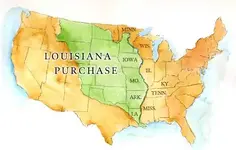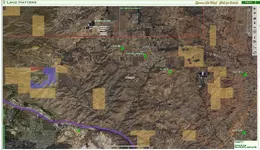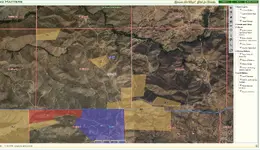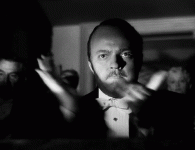I've read the WIKI and other information, but REALLY what is up with the patch work areas that BLM manage? I'm looking at large sections of open mountains with seemingly random patches of BLM land scattered around. What am I missing here? Whis valley and not the ones next to it. Why that creek and not the next one. Is there something special about the patches that remain public?
Because everything is better with pictures:
View attachment 1469714View attachment 1469720
An excellent question with an answer that explains how the United States became such a rich nation.

We've got to go back a ways in history to explain this so please bear with me. I'll try to give you the simplified version.

When the United States won it's freedom from England there were only 13 colonies. The federal government didn't have any land until 12 years later with the new Constitution, then it got the 10 square miles where Washington D.C. is today.
During the same time as the new Constitution was being written the Northwest Ordinance was passed settling the matter of the former colonies that had extensive western land holdings. The States in the area now known as the upper midwest occupy those lands. Still there was only 10 square miles of federal government land but those Northwest Ordinance lands set the basis for what was to become Federal Public Lands.
It wasn't until 16 years later when Jefferson purchased Louisiana that Public Lands exceeded that 10 square miles. Louisiana at that time was huge - almost half the land west of the Mississippi river:

That's a whole lot of land and there was a huge bill to pay - nearly 84,000 pounds of gold.

The U.S. had nothing close to that much money and there were serious doubts as to whether the government ownership was even legal. The solution? Declare the land to belong to the
people of the United States and offer it for sale to individuals to raise the money for the purchase. It worked! The bill was paid on time and the people of the United States now owned Public Land - a whole bunch of it!
This Public Land was added to over the next 50 years mostly by starting wars and winning them. Winning being a relative term - Mexico charged us another 15 million dollars for the Southwest after we invaded their country and held their Congress hostage.

Of course all that land is pretty much worthless if you don't do something with it. That's where self initiated Patents came in. It started with the Northwest Ordinance, turned into the Kansas land rush and eventually became about a hundred different ways to get some public land for yourself.
The Patent process required a U.S. citizen to occupy the open land they wanted, follow the requirements to qualify for that particular type of Patent and then make an "Entry" with the General Land Office. The entry was the application and included a payment of a set small amount per acre claimed. If everything was in order the Patent was granted and the title was transferred from the United States to the Patentee. The land then became privately owned and was no longer Public Land.
Imagine that originally back in the early 1800's all that Public Land would have been shown as "BLM" managed on the map you shared. As the patents were issued those parcels of Public Land would be removed from the map of public managed lands. Eventually all of the land east of the Rockies were transferred to private individuals and much of the Public Land west of the Rockies useful for farming or mining were also transferred out of the public domain by patent.
Those "patches" of BLM managed land on the map were at one time whole large areas. What you see as patches are the areas that were not patented and transferred into private ownership. Those long rectangles missing in the middle were lode claim (mining) patents. Much of the rest of the private lands were homestead patents.
More than 6 million patents were granted over 172 years creating virtually all of the privately owned land outside of the 13 original States. Where you live and work was most likely public land at one time until it was patented.
Patents were fairly common knowledge when I was growing up in the West. The most common patents, Homestead patents, were still a possibility. Mining claims were regularly taken to patent. Most of that ended in 1976 when Congress passed the Federal Land Policy Management Act. The
FLPMA abolished all self initiated patents with the single exception of mining claim patents. The FLPMA changed the 172 year old government policy of public lands belonging to the people. It is now the policy of the United States that the Public Lands belong to the government rather than the people of the United States
Only mining patents are still a possiblity after FLPMA but Congress has defunded the processing of mining claim patent processing in every budget since 1993. Mining claim patents will resume when Congress passes a budget that does not withhold that money.
So how did all this make America rich? Back in the old days before 1971 gold and silver were money. The United States was very money (gold & silver) poor until the 1850's. Up until then the only way to get money was to grow or make something that could be exported and sold for gold or silver. If folks don't have land they can't farm or mine so they can't make stuff for export. A lot of countries have this problem of too little land and too little mineable metals. The U.S. had few metal mines to drive their economy but they did have land - oodles of land. So much land that everyone could grow enough extra stuff to export and get money.
Up until the 1850's this lack of money thing led to a lot of bartering and trading. The U.S. didn't even have enough gold and silver to mint their own coin. We used mostly Spanish silver coins when we couldn't trade or barter. After 1850 the western lands were opened to exploration and settlers and the money (gold and silver) started flowing. So much gold and silver we became the richest nation on earth.
If it hadn't been for the inexpensive farming and mining land grants the U.S. would still be trying to trade cotton, shoes and buttons for British silver and French gold. Thanks to the patent grants each individual willing to do the work could become a wealthy land owner. Wealthy people = wealthy nation.
It's not just a nations resource's that make it successful. Mexico has incredible natural resources, on a par with the United States. The people of Mexico are by and large poor by our standards. The difference? Mexicans seldom own the resources of the land. In the United States we settled land that already belonged to us, we just had to follow the rules and pay a minimal acreage fee and we could own the land's resources ourselves.
So those little patches of land you see are what is left of the greatest land rush in history.
Heavy Pans













